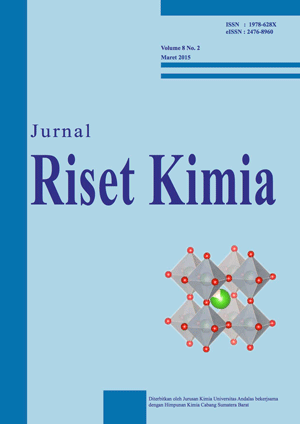TRANSPOR IODIN MELALUI MEMBRAN KLOROFORM DENGAN NATRIUM TIOSULFAT SEBAGAI FASA PENERIMA DALAM TEKNIK MEMBRAN CAIR FASA RUAH
DOI:
https://doi.org/10.25077/jrk.v8i2.232Keywords:
Transport Iodine, Bulk Liquid Membrane Technique, Sodium ThiosulphateAbstract
Iodine transport throught bulk liquid membrane technique consist of 10 mL I2/KI 4x10-3 N solution as donor phase, 20 mL Na2S2O3 0.02 N solution as reagent striping in acceptor phase, and 30 mL chloroform as membrane phase. Technical operation use magnetic stirring at 100 rpm. Concentration of iodine in donor phase and acceptor phase determined by Spectrophotometer UV-Vis λ max at 567 nm. The results concluded that the optimum conditions of iodine transport 4 x 10-3 N with pH 7 in donor phase, comparison I2:KI in donor phase (1:5), and a long stirring is 120 minutes. The bulk liquid membrane technique with Na2S2O3 as reagent striping in acceptor phase is potential for iodine transport from donor phase to acceptor phase with 86.71 % of iodine transport. Fluxs values (transport rate) generated by using chloroform membrane of 1.8872 x 10-7 L/cm2.menit-1 at a maximum transport time of 120 minutes.
References
Samuel Finley,†Pengelolaan Limbah Klinis Rumah Sakit,†Tesis Pasca Sarjana UI (2004).
Nabieyan,A. Kargari, T Kaghazchi, A.Mahmoudian, M.Soleimani “Bench-Scale Pertraction of Iodine Using a Bulk Liquid Membrane System†, Desalination (214) 167-176.
Departemen Kesehatan Republik Indonesia. “Farmakope Indonesia, edisi IVâ€: Depkes RI. Hal 316-317 (2001).
Refinel, Imelda and Novas vania. Transpor Iodin Melalui Kloform dengan Vitamin C Sebagai fasa Akseptor Dalam Teknik membran Cair Fasa Ruah†Proseding Seminar Nasional HKI 1 (2013)197-202.
Refinel, Zaharasmi and Sukmawita, Transpor Iodin melalui membran Kloroform dengan Teknik Membran Cair Fasa Ruah. Jurnal Riset Kimia 5 (2011) 53 – 59.
Savafi, and Shams. E. Selective and Efficient Transport of Hg(II) Through Bulk Liquid Membrane Using Methyl Red as Carrier. J. Membrane Sci 144 (1998) 37-43.
Day. R. A and Under wood. A. L, Analisis Kimia Kuantitatifâ€, Edisi VI , Airlangga. Jakarta, (2002).
Mulder, M., Basic Principle of Membran technologyâ€. Kluwer Academic Publisher, Dordrencht. pp. 244-259. (1991).
Refinel, Zaharasmi and Olly. Kinetika Transpor Cu(II) oleh zat pembawa Oksin dengan dan tanpa asam Oleat melalui membran cair fasa ruah. Jurnal Riset Kimia 2 (2009) 127 – 131.
Kahar Z., Mustafa D., and Wiwit. Kinetika dan Mekanisme Transpor Cd(II) Antar Fasa melalui Teknik Membran Cair Fasa Ruah Dengan Oksin Sebagai Zat pembawa. Jurnal Riset Kimia 1 (2007) 97 -100.
Refinel. Optimalisasi Transpor Cu(II) dengan Zat Pembawa Metil Merah Melalui Teknik Membran Cair Fasa Ruah. Proseding Semirata FMIPA-Unja Jambi (2005) 17-19.
Refinel. Penentuan Kondisi Optimum Transpor Ion Cd(II) melalui Teknik Membran Cair Fasa Ruah secara Simultan dengan Oksin sebagai pembawa. Proseding Semirata FMIPA – Unri Pekanbaru (2010 ).
Refinel, Zaharasmi and Olly. Kinetika dan Selektifitas Transpor Cu(II) antara fasa melalui membran Cair Fasa Ruah dengan Oksin sebagai zat pembawa. Jurnal Riset Kimia 4 (2010) 63-72.
Refinel. Optimasi Transpor Fenol melalui Membran Cair Kloform dalam Teknik Fasa Ruah, Proseding Seminar Nasional HKI PekanBaru (2011) 18-19.
Downloads
Published
How to Cite
Issue
Section
Citation Check
License
Please find the rights and licenses in Jurnal Riset Kimia (J. Ris. Kim). By submitting the article/manuscript of the article, the author(s) agree with this policy. No specific document sign-off is required.
1. License
The use the article will be governed by the Creative Commons Attribution license as currently displayed on Creative Commons Attribution 4.0 International License.Â
2. Author(s)' Warranties
The author warrants that the article is original, written by stated author(s), has not been published before, contains no unlawful statements, does not infringe the rights of others, is subject to copyright that is vested exclusively in the author and free of any third party rights, and that any necessary written permissions to quote from other sources have been obtained by the author(s).
3. User Rights
Under the Creative Commons license, the journal permits users to copy, distribute, and display the material for any purpose. Users will also need to attribute authors and J. Ris. Kim on distributing works in the journal and other media of publications.
4. Rights of Authors
Authors retain all their rights to the published works, such as (but not limited to) the following rights;
- Copyright and other proprietary rights relating to the article, such as patent rights,
- The right to use the substance of the article in own future works, including lectures and books,
- The right to reproduce the article for own purposes,
- The right to self-archive the article,
- The right to enter into separate, additional contractual arrangements for the non-exclusive distribution of the article's published version (e.g., post it to an institutional repository or publish it in a book), with an acknowledgment of its initial publication in this journal.
5. Co-Authorship
If the article was jointly prepared by more than one author, any authors submitting the manuscript warrants that he/she has been authorized by all co-authors to be agreed on this copyright and license notice (agreement) on their behalf, and agrees to inform his/her co-authors of the terms of this policy. J. Ris. Kim will not be held liable for anything that may arise due to the author(s) internal dispute. J. Ris. Kim will only communicate with the corresponding author.












